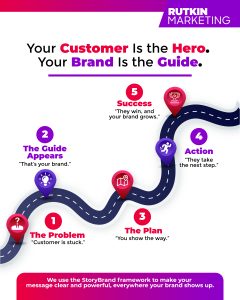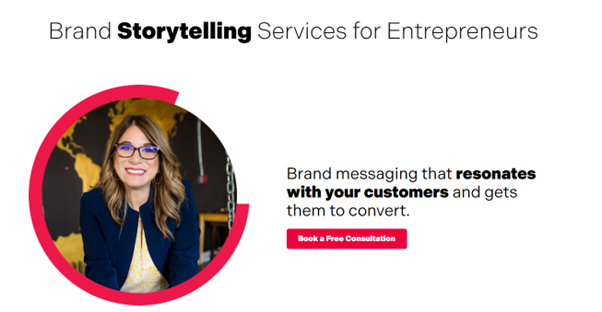How to Build a High-Converting Sales Funnel Using the StoryBrand Framework

You’ve built a sales funnel. You’ve got web traffic. Maybe even a few leads. But somewhere between attention and action, things fall apart.
If you’re like most B2B companies, your sales funnel isn’t broken because your product isn’t good. It’s broken because your messaging is unclear, and your prospects don’t know why they should care.
That’s where the StoryBrand sales funnel comes in.
By using proven storytelling principles of the StoryBrand Framework, you can transform your funnel into a clear, compelling journey that attracts the right audience, nurtures trust, and converts leads into clients, without being pushy or gimmicky.
Let’s break it down.
Why Traditional Sales Funnels Fall Flat
Most funnels follow the same formula: offer a lead magnet, drop new contacts into a drip campaign, and hope a small percentage converts.
The problem? Most messaging is self-focused. It talks about features, not problems. It lists credentials instead of showing empathy. And it leaves your audience wondering, “So what?”
StoryBrand flips the script by making your customer the hero and positioning your brand as the guide. When your funnel follows this narrative structure, it instantly becomes more relatable, more persuasive, and more effective.
How to Structure Your Sales Funnel Using StoryBrand
Let’s walk through how to create a sales funnel with StoryBrand, stage by stage.
Awareness Stage: Attracting the Right Audience
 Your customer is the hero, and your brand is the guide. This is where your brand enters the customer’s story. Instead of trying to stand out by being louder, focus on being clearer. Your homepage, landing pages, and top-of-funnel content should answer three questions quickly:
Your customer is the hero, and your brand is the guide. This is where your brand enters the customer’s story. Instead of trying to stand out by being louder, focus on being clearer. Your homepage, landing pages, and top-of-funnel content should answer three questions quickly:
What problem does your customer face?
What’s at stake if they don’t solve it?
How do you help?
Use StoryBrand messaging in your communications and support it with lead magnets—guides, checklists, or webinars—that address an immediate and relevant pain point. The purpose here is to connect, not convert. You’re showing prospects that you understand their world better than most.
In Building a StoryBrand: Clarify Your Message So Customers Will Listen, Donald Miller explains that customers engage more deeply with brands that tell relatable stories rather than focusing solely on self-promotion. As we’ve highlighted in previous articles, the StoryBrand Framework provides a clear path to solve these challenges by refining and clarifying your message so it truly connects with the people you want to reach.
Avoid opening with a pitch. Lead with clarity and authenticity—especially in visual storytelling. Clarity builds trust, and trust drives action.
Consideration Stage: Nurturing with Storytelling
Once someone opts in, your job is to guide, not push, them forward.
This stage is where StoryBrand lead generation strategies shine. Create email sequences that follow the StoryBrand Framework: empathize with their challenge, offer a clear plan, and remind them of what success (or failure) looks like.
Instead of listing product features, share short stories. Talk about people like them, solving problems they care about, with your help. When a prospect sees themselves in the story, conversion becomes a natural next step.
Include proof in the form of testimonials or case studies, but frame them as transformation stories, not just endorsements. Show the before, during, and after.
Decision Stage: Closing with Clarity
You’ve built trust. Now it’s time to offer a decision.
At this point in your StoryBrand sales funnel, the message should shift from nurturing to activating. Your landing pages, communications, and sales conversations should clearly present an offer to solve their problem and a direct next step.
Keep the offer simple. Be specific about what they get, how it works, and what’s required from them. Don’t bury your call to action. Make it easy to say yes.
Use language that reminds them of the problem they’re trying to solve, and what success looks like if they move forward. When you paint a clear picture of transformation, you reduce friction and increase urgency.
How to Implement StoryBrand in Lead Nurturing Campaigns
Here’s how to put this into action across your marketing and sales efforts:
- Tell stories that show transformation – Use success stories that highlight the problems your audience faces, and how your solution made a measurable difference. Frame them as narratives, not just case studies.
- Build email sequences with structure and strategy – Each message should guide the prospect through a stage of the journey, not just fill their inbox. Reference the core StoryBrand elements in every step: problem, guide, plan, action, and success.
- Map the full customer journey – Consistency matters. Make sure your ads, landing pages, emails, and follow-up content all reinforce the same core message. Disjointed messaging creates confusion and doubt; cohesive storytelling builds trust.
Case Study: From Confusing Funnel to Six-Figure Pipeline
A growing B2B SaaS company came to us with a common challenge: solid product, plenty of traffic, but poor conversions.
We rebuilt their sales funnel using the StoryBrand framework, starting with clear landing page messaging and a three-part lead-nurturing sequence. We shifted the tone from feature-heavy to customer-focused. The result?
- 38% increase in lead-to-call conversion.
- Double the demo bookings within eight weeks.
- Over 6-figures in new revenue within just four months.
They didn’t change their offer. They changed their story, and that made all the difference.
Final Thoughts: Story First, Funnel Second
Most companies don’t need more tech or tactics. They need a clearer message and a more human connection.
If your funnel isn’t converting, start by asking: Is it telling a compelling story?
At Rutkin Marketing, we help B2B companies with brand storytelling to create high-converting sales funnels that guide prospects to action, without the gimmicks.
Want help applying this to your business? Let’s talk.

